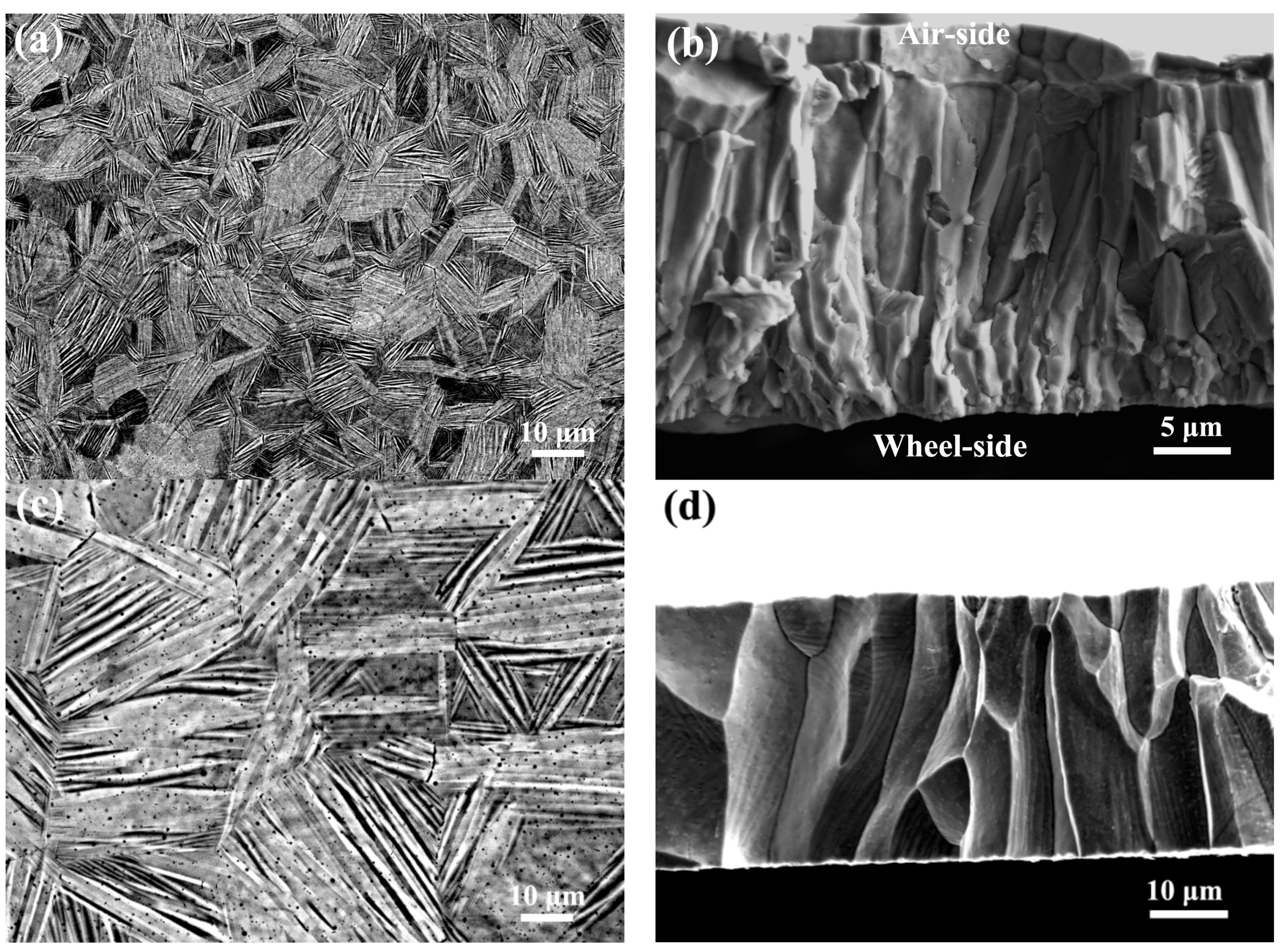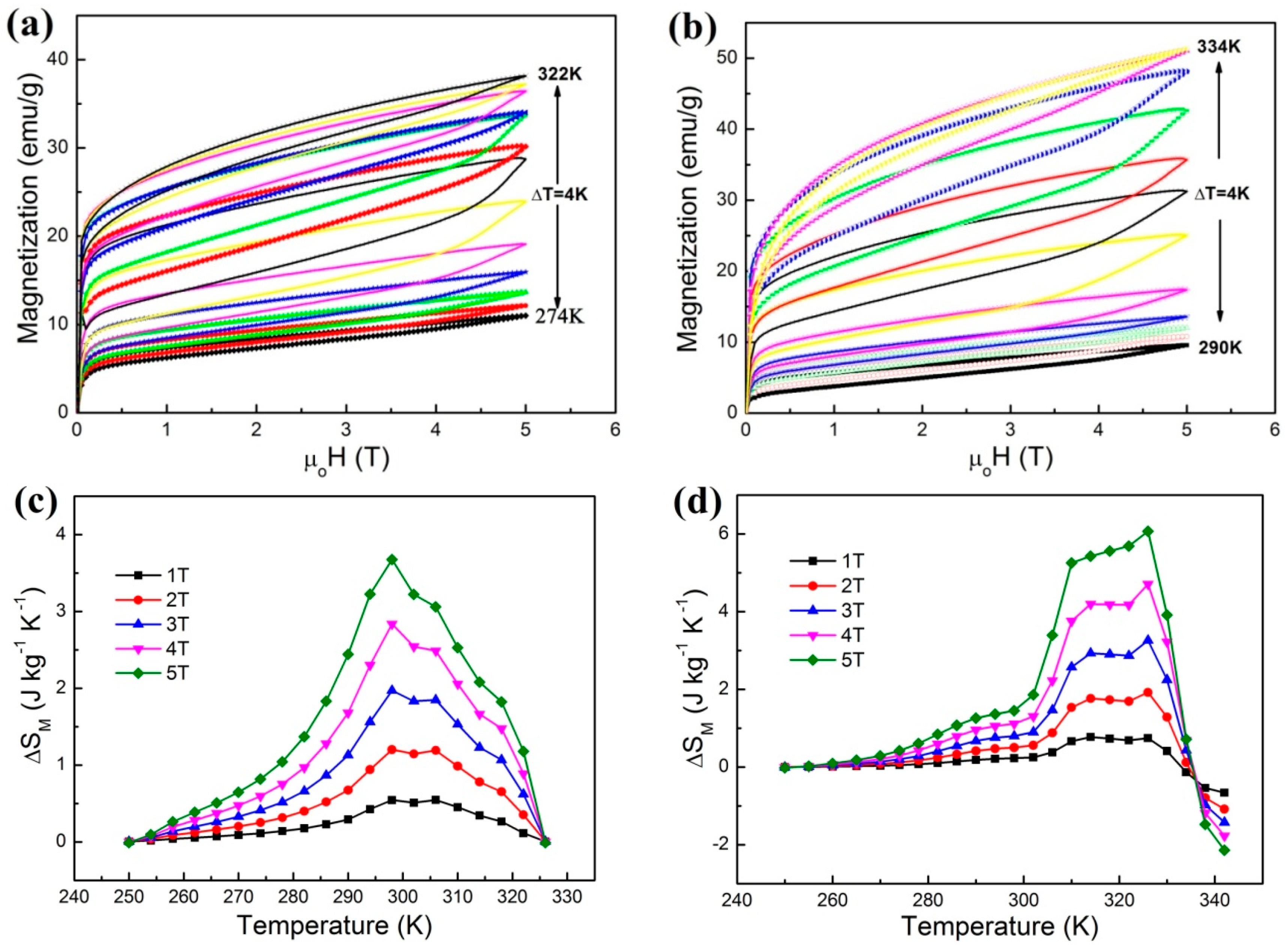Microstructural Feature and Magnetocaloric Effect of Mn50Ni40.5In9.5 Melt-Spun Ribbons
Abstract
:1. Introduction
2. Experimental
3. Results and Discussion
3.1. Martensitic Transformation
3.2. Crystal Structure
3.3. Microstructure
3.4. Magnetocaloric Effects
4. Summary
Acknowledgments
Author Contributions
Conflicts of Interest
References
- Pecharsky, V.K.; Gschneidner, K.A., Jr. Magnetocaloric effect and magnetic refrigeration. J. Magn. Magn. Mater. 1999, 200, 44–56. [Google Scholar] [CrossRef]
- Planes, A.; Mañosa, L.; Acet, M. Magnetocaloric effect and its relation to shape-memory properties in ferromagnetic Heusler alloys. J. Phys. Condens. Matter 2009, 21, 233201. [Google Scholar] [CrossRef] [PubMed]
- Gutfleisch, O.; Willard, M.A.; Brück, E.; Chen, C.H.; Sankar, S.G.; Liu, J.P. Magnetic materials and devices for the 21st century: Stronger, lighter, and more energy efficient. Adv. Mater. 2011, 23, 821–842. [Google Scholar] [CrossRef] [PubMed]
- Yu, B.F.; Gao, Q.; Zhang, B.; Meng, X.Z.; Chen, Z. Review on research of room temperature magnetic refrigeration. Int. J. Refrig. 2003, 26, 622–636. [Google Scholar] [CrossRef]
- Kainuma, R.; Imano, Y.; Ito, W.; Sutou, Y.; Morito, H.; Okamoto, S.; Kitakami, O.; Oikawa, K.; Fujita, A.; Kanomata, T.; et al. Magnetic-field-induced shape recovery by reverse phase transformation. Nature 2006, 439, 957–960. [Google Scholar] [CrossRef] [PubMed]
- Kainuma, R.; Imano, Y.; Ito, W.; Morito, H.; Sutou, Y.; Oikawa, K.; Fujita, A.; Ishida, K.; Okamoto, S.; Kitakami, O.; et al. Metamagnetic shape memory effect in a Heusler-type Ni43Co7Mn39Sn11polycrystalline alloy. Appl. Phys. Lett. 2006, 88, 192513. [Google Scholar] [CrossRef]
- Liu, J.; Gottschall, T.; Skokov, K.P.; Moore, J.D.; Gutfleisch, O. Giant magnetocaloric effect driven by structural transitions. Nat. Mater. 2012, 11, 620–626. [Google Scholar] [CrossRef] [PubMed]
- Yu, S.Y.; Liu, Z.H.; Liu, G.D.; Chen, J.L.; Cao, Z.X.; Wu, G.H.; Zhang, B.; Zhang, X.X. Large magnetoresistance in single-crystalline Ni50Mn50−xInx alloys (x = 14–16) upon martensitic transformation. Appl. Phys. Lett. 2006, 89, 162503. [Google Scholar] [CrossRef]
- Li, H.; Feng, S.; Ren, J.; Zhai, Q.; Fu, J.; Luo, Z.; Zheng, H. Magnetostructural transitions in Mn-rich Heusler Mn–Ni–In melt-spun ribbons with enhanced magnetocaloric effect. J. Magn. Magn. Mater. 2015, 391, 17–21. [Google Scholar] [CrossRef]
- Sánchez Llamazares, J.L.; Hernando, B.; Prida, V.M.; García, C.; González, J.; Varga, R.; Ross, C.A. Magnetic field influence on the structural transformation in ferromagnetic shape memory alloy Mn50Ni40In10 melt spun ribbons. J. Appl. Phys. 2009, 105, 07A945. [Google Scholar] [CrossRef]
- Xuan, H.C.; Ma, S.C.; Cao, Q.Q.; Wang, D.H.; Du, Y.W. Martensitic transformation and magnetic properties in high-Mn content Mn50Ni50−xInx ferromagnetic shape memory alloys. J. Alloys Compd. 2011, 509, 5761–5764. [Google Scholar] [CrossRef]
- Hernando, B.; SanchezLlamazares, J.L.; Prida, V.M.; Baldomir, D.; Serantes, D.; Ilyn, M.; González, J. Magnetocaloric effect in preferentially textured Mn50Ni40In10 melt spun ribbons. Appl. Phys. Lett. 2009, 94, 222502. [Google Scholar] [CrossRef]
- Ren, J.; Li, H.W.; Feng, S.T.; Zhai, Q.J.; Fu, J.X.; Luo, Z.P.; Zheng, H.X. Giant magnetocaloric effect in a Heusler Mn50Ni40In10 unidirectional crystal. Intermetallics 2015, 65, 10–14. [Google Scholar] [CrossRef]
- Ren, J.; Tong, S.T.; Fang, Y.; Zhai, Q.J.; Luo, Z.P.; Zheng, H.X. Enhanced magnetocaloric effect in a Co-doped Heusler Mn50Ni37Co3In10 unidirectional crystal. J. Phys. Chem. Solids 2016, 98, 233–236. [Google Scholar] [CrossRef]
- SánchezLlamazares, J.L.; Sanchez, T.; Santos, J.D.; Pérez, M.J.; Sanchez, M.L.; Hernando., B. Martensitic phase transformation in rapidly solidified Mn50Ni40In10 alloy ribbons. Appl. Phys. Lett. 2008, 92, 012513. [Google Scholar]
- Pons, J.; Chernenko, V.A.; Santamarta, R.; Cesari, E. Crystal structure of martensitic phases in Ni-Mn-Ga shape memory alloys. Acta Mater. 2000, 48, 3027–3038. [Google Scholar] [CrossRef]
- Caballero-Flores, R.; Franco, V.; Conde, A.; Kiss, L.F. Influence of the demagnetizing field on the determination of the magnetocaloric effect from magnetization curves. J. Appl. Phys. 2009, 105, 07A919. [Google Scholar] [CrossRef]
- Ma, S.C.; Cao, Q.Q.; Xuan, H.C.; Zhang, C.L.; Shen, L.J.; Wang, D.H. Magnetic and magnetocaloric properties in melt-spun and annealed Ni42.7Mn40.8Co5.2Sn11.3 ribbons. J. Alloys Compd. 2011, 509, 1111–1114. [Google Scholar] [CrossRef]
- Chernenko, V.A.; Cesari, E.; Pons, J.; Seguí, C. Phase transformations in rapidly quenched Ni-Mn-Ga alloys. J. Mater. Res. 2000, 15, 1496–1504. [Google Scholar] [CrossRef]
- Liu, J.; Scheerbaum, N.; Hinz, D.; Gutfleisch, O. Magnetostructural transformation in Ni-Mn-In-Co ribbons. Appl. Phys. Lett. 2008, 92, 162509. [Google Scholar] [CrossRef]
- Cai, W.; Feng, Y.; Sui, J.H.; Gao, Z.Y.; Dong, G.F. Microstructure and martensitic phase transformation behavior of the Ni50Mn36In14 melt-spun ribbons. Scr. Mater. 2008, 58, 830–833. [Google Scholar] [CrossRef]
- Chernenko, V.A.; Seguí, C.; Cesari, E.; Pons, J.; Kokorin, V.V. Sequence of martensitic transformations in Ni-Mn-Ga alloys. Phys. Rev. B 1998, 57, 2659–2662. [Google Scholar] [CrossRef]
- Sutou, Y.; Imano, Y.; Koeda, N.; Omori, T.; Kainuma, R.; Ishida, K.; Oikawa, K. Magnetic and martensitic transformations of NiMnX (X=In,Sn,Sb) ferromagnetic shape memory alloys. Appl. Phys. Lett. 2004, 85, 4358–4360. [Google Scholar] [CrossRef]
- Nishida, M.; Hara, T.; Matsuda, M.; Ii, S. Crystallography and morphology of various interfaces in Ti-Ni, Ti-Pd and Ni-Mn-Ga shape memory alloys. Mater. Sci. Eng. A 2008, 481, 18–27. [Google Scholar] [CrossRef]
- Li, Z.B.; Yang, B.; Zhang, Y.D.; Esling, C.; Zou, N.F.; Zhao, X.; Zuo, L. Crystallographic insights into the intermartensitic transformation in Ni-Mn-Ga alloys. Acta Mater. 2014, 74, 9–17. [Google Scholar] [CrossRef]
- Li, Z.B.; Zhang, Y.D.; Esling, C.; Zhao, X.; Zuo, L. Determination of the orientation relationship between austenite and incommensurate 7M modulated martensite in Ni-Mn-Ga alloys. Acta Mater. 2011, 59, 2762–2772. [Google Scholar] [CrossRef]
- Quintana-Nedelcos, A.; Sánchez Llamazares, J.L.; Sánchez-Valdés, C.F.; Álvarez Alonso, P.; Gorria, P.; Shamba, P.; Morley, N.A. On the correct estimation of the magnetic entropy change across the magneto-structural transition from the Maxwell relation: Study of MnCoGeBx alloy ribbons. J. Alloys Compd. 2017, 694, 1189–1195. [Google Scholar] [CrossRef]
- Liu, J.; Scheerbaum, N.; Lyubina, J.; Gutrleisch, O. Reversibility of magnetostructural transition and associated magnetocaloric effect in Ni-Mn-In-Co. Appl. Phys. Lett. 2008, 93, 102512. [Google Scholar] [CrossRef]
- Jiang, Y.; Li, Z.; Li, Z.; Yang, Y.; Yang, B.; Zhang, Y.; Esling, C.; Zhao, X.; Zuo, L. Magnetostructural transformation and magnetocaloric effect in Mn-Ni-Sn melt-spun ribbons. Eur. Phys. J. Plus 2017, 132, 42. [Google Scholar] [CrossRef]






| Ribbons | Ms (K) | Mf (K) | As (K) | Af (K) |
|---|---|---|---|---|
| Melt-spun | 272 | 254 | 285 | 302 |
| Annealed | 297 | 279 | 301 | 321 |
© 2017 by the authors. Licensee MDPI, Basel, Switzerland. This article is an open access article distributed under the terms and conditions of the Creative Commons Attribution (CC BY) license (http://creativecommons.org/licenses/by/4.0/).
Share and Cite
Yang, Y.; Li, Z.; Li, Z.; Yang, J.; Yang, B.; Dong, Y.; Yan, H.; Zhang, Y.; Esling, C.; Zhao, X.; et al. Microstructural Feature and Magnetocaloric Effect of Mn50Ni40.5In9.5 Melt-Spun Ribbons. Crystals 2017, 7, 289. https://doi.org/10.3390/cryst7100289
Yang Y, Li Z, Li Z, Yang J, Yang B, Dong Y, Yan H, Zhang Y, Esling C, Zhao X, et al. Microstructural Feature and Magnetocaloric Effect of Mn50Ni40.5In9.5 Melt-Spun Ribbons. Crystals. 2017; 7(10):289. https://doi.org/10.3390/cryst7100289
Chicago/Turabian StyleYang, Yiqiao, Zongbin Li, Zhenzhuang Li, Jiajing Yang, Bo Yang, Yu Dong, Haile Yan, Yudong Zhang, Claude Esling, Xiang Zhao, and et al. 2017. "Microstructural Feature and Magnetocaloric Effect of Mn50Ni40.5In9.5 Melt-Spun Ribbons" Crystals 7, no. 10: 289. https://doi.org/10.3390/cryst7100289






